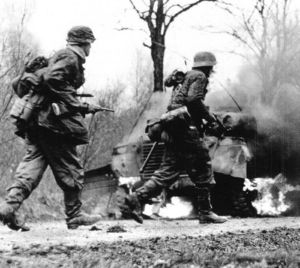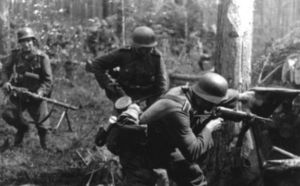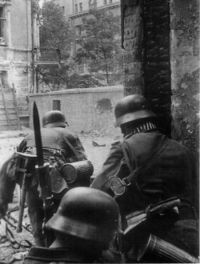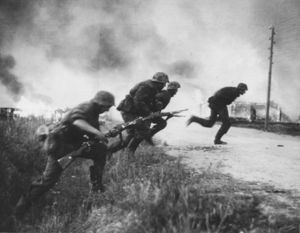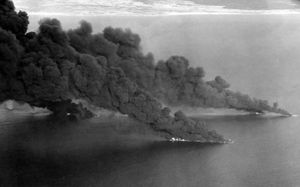Difference between revisions of "10 Days War"
| Line 119: | Line 119: | ||
* The XIV VS-Panzerkorps was ordered to seize the town of Grünberg on the northwest prong of the attack. A Fighter Wing and Ground Attack Wing of the Rotgeheim Air Force were assigned to the XIV VS-Panzerkorps during the advance. As with the previous two Panzerkorps, the XIV was to defend the town once taken and await reinforcements. | * The XIV VS-Panzerkorps was ordered to seize the town of Grünberg on the northwest prong of the attack. A Fighter Wing and Ground Attack Wing of the Rotgeheim Air Force were assigned to the XIV VS-Panzerkorps during the advance. As with the previous two Panzerkorps, the XIV was to defend the town once taken and await reinforcements. | ||
| − | The XII VS-Panzerkorps departed Widerhausen around 5:30 a.m. and drove its armor full throttle to the entrenched troops in the area surrounding [[File:StreetPanzergrenadiere.jpeg|200px|thumbnail|right|Panzergrenadiers of the XII VS-Panzerkorps begin to advance from behind a building during the fighting for Neuhäusser, Hundermenschen]] Neuhäusser. The 14th VS-Panzergrenadier Division ''Balkan'' made contact with Porantan forces at 6:15 a.m. along the eastern trenches outside Neuhäusser. The rest of the XII VS-Panzerkorps attacked on the southern side of the town, the brunt force of the assault quickly overwhelming the defending troops and forcing them to retreat deeper into the town itself. A full Porantan armored division attempted to encircle the attacking Rotgeheim troops, but was unable to because of the frequent losses they sustained due to the dive | + | The XII VS-Panzerkorps departed Widerhausen around 5:30 a.m. and drove its armor full throttle to the entrenched troops in the area surrounding [[File:StreetPanzergrenadiere.jpeg|200px|thumbnail|right|Panzergrenadiers of the XII VS-Panzerkorps begin to advance from behind a building during the fighting for Neuhäusser, Hundermenschen]] Neuhäusser. The 14th VS-Panzergrenadier Division ''Balkan'' made contact with Porantan forces at 6:15 a.m. along the eastern trenches outside Neuhäusser. The rest of the XII VS-Panzerkorps attacked on the southern side of the town, the brunt force of the assault quickly overwhelming the defending troops and forcing them to retreat deeper into the town itself. A full Porantan armored division attempted to encircle the attacking Rotgeheim troops, but was unable to because of the frequent losses they sustained due to the dive bombers of VS-Ground Attack Wing 8. Porantan fighter planes made their first appearance in the entire war above Neuhäusser, but they proved ineffective against the highly maneuverable and well-armed Rotgeheiman planes. The trenches were cleared out by advancing Panzergrenadiers of the 14th VS-Panzergrenadier Division by 10:00 a.m. and the rest of the defending Porantan troops in the town were forced out by 11:30 a.m. |
| − | bombers of VS-Ground Attack Wing 8. Porantan fighter planes made their first appearance in the entire war above Neuhäusser, but they proved ineffective against the highly maneuverable and well-armed Rotgeheiman planes. The trenches were cleared out by advancing Panzergrenadiers of the 14th VS-Panzergrenadier Division by 10:00 a.m. and the rest of the defending Porantan troops in the town were forced out by 11:30 a.m. | + | |
The XIV VS-Panzerkorps also departed its resting area around 5:30 a.m. on January 24th. Since its objective was farther away than the other two, the Panzerkorps did not reach the outskirts of Grünberg until around 6:45 a.m. First contact with the Porantan troops entrenched around Grünberg was made at 7:00 a.m., when a Rotgeheiman reconnaissance unit dispatched to scout the town was ambushed. They radioed for help, and in a fashion similar to the [[Battle of Bloody Gulch]], more and more troops joined the fight. The 27th VS-Panzer Division ''Finnmarck'' was the first to respond to the distress signal and provided covering fire of the reconnaissance unit to allow it to pull out. The arrival of the 24th VS-Panzergrenadier Division ''Maria Theresia'' allowed for a two-pronged counterattack to commence on the town. [[File:Nordpreussen.jpeg|300px|thumbnail|right|Northern Prussian soldiers of the 24th VS-Panzergrenadier Division ''Maria Theresia'' storm across a road during the fighting for Grünberg, Hundermenschen.]] The 27th VS headed quickly around the left flank of the Porantan forces and thrust into the weak defenses on the rear. The 24th attacked headlong into the front defenses, assisted by the 17th VS-Panzergrenadier Division ''Furtwängler''. Porantan forces were now cut off from the rear, and unable to retreat eastward because of the cliffs that dropped off into the sea below. Porantan soldiers abandoned their posts and attempted to flee west, and although many did escape capture, many more were killed in the attempt. The town was reported as seized at 8:00 a.m. | The XIV VS-Panzerkorps also departed its resting area around 5:30 a.m. on January 24th. Since its objective was farther away than the other two, the Panzerkorps did not reach the outskirts of Grünberg until around 6:45 a.m. First contact with the Porantan troops entrenched around Grünberg was made at 7:00 a.m., when a Rotgeheiman reconnaissance unit dispatched to scout the town was ambushed. They radioed for help, and in a fashion similar to the [[Battle of Bloody Gulch]], more and more troops joined the fight. The 27th VS-Panzer Division ''Finnmarck'' was the first to respond to the distress signal and provided covering fire of the reconnaissance unit to allow it to pull out. The arrival of the 24th VS-Panzergrenadier Division ''Maria Theresia'' allowed for a two-pronged counterattack to commence on the town. [[File:Nordpreussen.jpeg|300px|thumbnail|right|Northern Prussian soldiers of the 24th VS-Panzergrenadier Division ''Maria Theresia'' storm across a road during the fighting for Grünberg, Hundermenschen.]] The 27th VS headed quickly around the left flank of the Porantan forces and thrust into the weak defenses on the rear. The 24th attacked headlong into the front defenses, assisted by the 17th VS-Panzergrenadier Division ''Furtwängler''. Porantan forces were now cut off from the rear, and unable to retreat eastward because of the cliffs that dropped off into the sea below. Porantan soldiers abandoned their posts and attempted to flee west, and although many did escape capture, many more were killed in the attempt. The town was reported as seized at 8:00 a.m. | ||
Revision as of 16:16, 21 July 2014
| 10 Days War | |||||||
|---|---|---|---|---|---|---|---|
Two Panzergrenadiers of the Verteidigungsstaffel advance past a burning Porantan vehicle in the outskirts of Widerhausen, Hundermenschen |
|||||||
|
|||||||
| Belligerents | |||||||
| Porant Volsvakia |
||||||
| Commanders and leaders | |||||||
| President of Porant
|
||||||
| Casualties and losses | |||||||
| Military Dead: 100,000 | Military Dead: 250,000 |
||||||
The 10 Days War was a conflict that began when Porant declared war on Hundermenschen due to the latter's lack of a democratic form of government. A "domino effect" resulted as several more nations were pulled into one of two sides. Initially, it seemed as if the attacking armies were going to be victorious, but as Hundermenschen called upon allies to assist, the invading forces were repulsed and forced to agree to peace out of fear of invasion themselves.
The short ten-day war inflicted hundreds of thousands of casualties on both sides. Hundermenschen received the most casualties out of all, due to their nation being the battleground in nearly all engagements.
Contents
Background
Porant was a strong country both politically and militarily that advocated strongly for democratic forms of government. The strong ties they held throughout their region and the world enabled them to meddle in matters globally, influencing foreign governments and decisions made in distant lands. Porant eventually took notice of Hundermenschen, a gigantic nation led by an autarch. Porant wished to flex its political muscles and demanded that Hundermenschen resort to a more democratic government, to which they received a negative reply. Tensions rose between the two nations as Porant repeatedly demanded for democratic rule in Hundermenschen. Hundermenschen continued dealing with its own internal issues (Hundermenschen was going through an intense drought at the time of this crisis) and ignored the barrage of threats from Porant.
Porant decided enough was enough and that matters had to be dealt with by force. Porant declared war on 17 January 1913 at 10:49 a.m.
Opening Hostilities
Porant Strikes First
Porantan Naval Forces began moving towards Hundermenschen a mere hour later. This was the beginning stage of Operation Groundforce, which the President of Porant personally designed. It entailed the Navy moving alone to the Northern Coastline of Hundermenschen, bombarding the cliff fortifications from the sea. Porant naval strength numbered two aircraft carriers, seventeen destroyers, two submarines, and fifteen military transport ships. This naval force was to be reinforced by the Porant Air Force which was tasked with overseeing the transport of troops onto the beach and up the cliffs.
The naval force assigned to invading Hundermenschen arrived at its destination around 3:20 p.m. The bombardment commenced immediately. The lightly-defended cliffs on the Northern Coastline sustained heavy casualties during the ensuing bombardment. The Porant Air Force arrived around 6:00 p.m. and immediately, along with the military transport ships, began ferrying troops onshore. Offloading troops sustained significant casualties due to the remaining defenders, although these losses were not substantial enough to halt progress. A beachhead was established by 8:30 p.m. Once word had been received by Hundermenschen High Command that such high damage had been done, several Hundermenschen Army Groups were assigned north, tasked with repulsing the invasion.
More Nations Join
After the initial strike on the Northern Coastline, Hundermenschen High Command realized the daunting task they were presented with. Luckily, The Goryevdre Islands realized the dire situation and came to assist. The Goryevdre Islands declared war on Porant and mobilized its Coast Guard and International Reaction Force. The latter was deployed to Hundermenschen the next day.
Porant was not without her allies, either. The Union of Socialist Republics of Volsvakia, a trade partner of Porant, declared war on Hundermenschen. Volsvakia justified the act by claiming Hundermenschen to be a threat to international business.
Buildup of Forces
Arrival of the Volsvakians
Late in evening on January 17th the first vessels of the 7th Shock Fleet of the Volsvakian Navy began arriving in the waters off the Northern Coastline. A large force of nearly forty ships - which was comprised of two aircraft carriers, several battleships and cruisers, several frigates, over a dozen destroyers, and many more transport ships - began to reinforce the already present Porantan forces. The flagship of the Volsvakian Navy, the VNS Gegemoniya, led the Volsvakian 7th Shock Fleet. Volsvakian Admiral Yuri Verchenko immediately contacted the Porantan commander and organized a meeting to begin planning for the next phase of Operation Groundforce.
Rotgeheim Joins the Fight
Hundermenschen, realizing the humongous threat now looming over, contacted a new ally. Rotgeheim was alerted to the ever-growing threat of annihilation that Hundermenschen faced and announced internationally on January 18th, 1913 that they would be intervening on the defending side. The Verteidigungsstaffel, a quick-reaction force separate from the military of Rotgeheim, was immediately and hastily sent to Hundermenschen. Nearly 300,000 troops were sent within the first two days. Rotgeheim Naval Forces and Air Forces were mobilized and sent around the Western Coast of Hundermenschen. Their responsibility was to destroy the navies of Porant and Volsvakia and eliminate any attempt at allowing them to further reinforce the troops already ashore.
First Engagements of the Verteidigungsstaffel
Breaching the Porantan Defensive Perimeter
The nearly 300,000 troops of the 1st VS Panzer Army (German: 1. VS-Panzerarmee) embarked upon the trek to engage the Porantan forces in the beachhead on the Northern Coast. The II VS-Panzerkorps (composed of the 1st VS-Panzer Division Kaiser Florian von Horn, 5th VS-Panzer Division Wiking, 11th VS-Panzergrenadier Division Selbstständigkeit, and 16th VS-Panzer Division Sturm) spearheaded the advance at the Porant forces. Unbeknownst to the Rotgeheim troops, however, the Porant forces had advanced nearly 50 km outside of the beachhead and were established in a spherical defensive position around the landing site.
The first engagement occurred early in the morning of January 20th, 1913. The 5th Reconnaissance Battalion of the 5th VS-Panzer Division Wiking encountered infantry (later revealed to be an infantry regiment) in a small village and fighting broke out between the two sides. The Rotgeheim troops radioed for help and nearby troops of the 1st VS-Panzer Division Kaiser Florian von Horn arrived at the battle scene. Porantan forces were quickly outnumbered as the technologically superior Rotgeheiman troops poured into the battle zone. The combined infantry and armor assaults by the 1st VS-Panzer Division and the 5th-VS Panzer Division allowed for the encirclement and destruction of defending Porantan forces. This battle came to be known as the Battle of Bloody Gulch, as many retreating Porantan units were herded into and subsequently destroyed in a low area between two roads. This engagement allowed for a 12 km-long incision to be sliced into the Porantan defensive perimeter by the II VS-Panzerkorps. This allowed for a definitive line to be drawn between the Porantan forces trying to maintain their beachhead and the attacking Rotgeheiman troops.
In the early hours in the afternoon of January 20th the lead battleships and superdreadnoughts of the Rotgeheim Navy encountered a small Porantan and Volsvakian convoy of three transport ships escorted by two destroyers just outside the North-western Coast of Hundermenschen. The extreme range of the 16" guns possessed by the H-class battleships in the Rotgeheim Navy vanguard was able to easily sink the slow-moving transport vessels before the escorting destroyers were able to intervene. The two destroyers then moved to engage the attacking Rotgeheiman Navy battleships and superdreadnoughts.
By 10:00 that evening the entirety of the flotilla assigned to engage the ships off the Northern Coast had assembled 100 km from their adversaries. Naval vessels of The Goryevdre Islands also began to trickle in around 12:00 a.m., with the remainder of the International Reaction Force reaching the rallying zone by 3:00 a.m. A sizable naval task force had now been assembled that numbered just over fifty vessels. Three aircraft carriers of the Rotgeheim Navy were also transporting several squadrons of fighters and dive-bombers of the Rotgeheim Air Force, with more planes expected to land at airstrips in Southern Hundermenschen the next day.
Further Attacks
Arrival of the XII and XIV VS-Panzerkorps
As the II VS-Panzerkorps bolstered its defensive area in the 12 km-long incision into Porantan territory the XII VS-Panzerkorps and the XIV VS-Panzerkorps arrived to reinforce troops already there. The addition of six new divisions (in the XII VS-Panzerkorps were the 9th VS-Panzer Division Hohenstaufen, 10th VS-Panzer Division Fuerstenburg, and 14th VS-Panzergrenadier Division Balkan; in the XIV VS-Panzerkorps were the 17th VS-Panzergrenadier Division Furtwängler, 24th VS-Panzergrenadier Division Maria Theresia, and 27th VS-Panzer Division Finnmarck.) significantly improved the chances of success for the attacking Rotgeheiman forces. On the 22nd of January Fall Rot (the code name for the next stage in the ground operation to repel the invading Porantan forces) was to begin.
Fall Rot Begins
At 5:30 a.m. on 22 January the offensive began. A three-pronged attack was planned, with the XII VS-Panzerkorps attacking on the left, the II VS-Panzerkorps in the center, and the XIV VS-Panzerkorps on the right. Fall Rot was broken up into a series of different objectives, with the ultimate goal of ridding Northern Hundermenschen of the invading Porantan forces. The first objective was encircling and destroying a large concentration of Porantan infantry and armor centered around the city of Widerhausen. Each VS-Panzerkorps was assigned a different goal during this opening phase.
- The XII VS-Panzerkorps was to assault left and eliminate all opposition in the way until reaching the Tiroler River – assuming the main bridge was intact, crossing would immediately begin, but if not, then Pioneers would arrive behind the advance guard to create a pontoon bridge. After crossing the Tiroler River the XII VS-Panzerkorps was to hook right and cut off the northern side of Widerhausen. From then on the Panzerkorps would be responsible for containing any breakout attempts the garrisoned Porantan troops would attempt to make, as well as repelling any relief efforts from the north.
- The II VS-Panzerkorps was tasked with assaulting the southern side of Widerhausen. All defending forces in the suburbs were to be destroyed. After eliminating all opposition to the forces defending the outskirts of Widerhausen, the II VS-Panzerkorps would then assault the city itself. Artillery bombardments would precede advancing into the city.
- The XIV VS-Panzerkorps was ordered to attack and destroy all enemy formations while making its way to a hilltop just before a tributary of the Tiroler River. Once reaching this area, the Panzerkorps was tasked with swinging left and advancing past the defending XII VS-Panzerkorps. Once past their defensive formations, the Panzerkorps was responsible to pushing back all relief efforts to the besieged garrison in Widerhausen.
The XIV VS-Panzerkorps quickly made it to their objective and repelled all subsequent relief efforts by Porantan forces. Widerhausen surrendered at 11:24 p.m. that night. Rotgeheiman forces now occupied a 30 km-deep, 25 km-wide salient in Porantan territory. The beachhead was now less than 20 km away.
Second Stage of Fall Rot
After the quick destruction of Porantan garrison at Widerhausen the next stage of the operation was to commence. The II, XII, and XIV VS-Panzerkorps were once again assigned individual objectives. Each formation was tasked with seizing a small town, which when all connected into a defensive perimeter, would encircle the Porantan forces at their beachhead. The Rotgeheim Air Force and the Wings of the VS were now able to give close support due to the two newly-acquired airstrips in Widerhausen. The second stage was set to begin at 5:30 a.m. on January 24th, 1913.
- The II VS-Panzerkorps was tasked with assaulting northward to the small town of Elssler. VS-Fighter Wing 2 Schwarze Ritter and VS-Ground Attack Wing 7 Schwarze Schafe were to support the advance. Once the town had been taken, a defensive perimeter would be set up and the Panzerkorps would await reinforcements.
- The XII VS-Panzerkorps was responsible for heading northeast and engaging the Porantan forces defending the town of Neuhäusser. VS-Fighter Wing 1 Wächter and VS-Ground Attack Wing 8 Kater would be in support. As with the II VS-Panzerkorps, the XII was to establish a defensive perimeter around the town and await reinforcements.
- The XIV VS-Panzerkorps was ordered to seize the town of Grünberg on the northwest prong of the attack. A Fighter Wing and Ground Attack Wing of the Rotgeheim Air Force were assigned to the XIV VS-Panzerkorps during the advance. As with the previous two Panzerkorps, the XIV was to defend the town once taken and await reinforcements.
The II VS-Panzerkorps departed their positions at 6:00 a.m. on the 24th, which was later than instructed. This was not to cause problems, however, as the Porantan forces were in no position to take advantage of this delay. The 5th VS-Panzer Division Wiking led the way with its heavy complement of PzKmpf XI Ausf. B Königspanthera. Enemy resistance was stiff on the way to the II VS-Panzerkorps' objective, but these tanks eased the advance. Although few in number, the heavy-caliber gun and impenetrable armor ensured that all opposing forces would be destroyed. A path was bulldozed through Porantan fortifications and the Panzerkorps arrived at Elssler at 6:45 a.m. The subsequent fighting was quick and brutal, with Panzergrenadiers storming through the streets at the retreating Porantan as fighters and dive bombers strafed the fleeing troops. Elssler was officially taken at 7:45 a.m.
The II, XII, and XIV VS-Panzerkorps of the 1st Panzer Army stationed around Elssler, Grünberg, and Neuhäusser were ordered to dig in and defend the line stretching across the three towns. The IV VS-Panzerkorps (composed of the 12th VS-Panzer Division Strahlfeld, 18th VS-Panzergrenadier Division Nordland, and 37th VS-Panzer Division Rote Teufel arrived in Widerhausen early in the morning on the 24th and would reinforce the II VS-Panzerkorps in Elssler. The offensive was scheduled to renew upon the arrival of the three new divisions.
Destruction of the Volsvakian Fleet
Although the Volsvakian 7th Shock Fleet was a sizable force, it was not a particularly advanced nor well-trained one. The aerial defenses on the ships were sub-par when compared to those used by the Rotgeheiman and Goryevdren navies, and the aircraft utilized by the naval aviation corps of Volsvakia was not much better. The coming battles would prove these notions as fact.
In the late evening of January 22nd the lead battleships of the Rotgeheiman Navy, accompanied by one aircraft carrier, the KM Schlüssel, began to head toward the left flank of the anchored Volsvakian Navy (this group was designated Battle Group A) The vanguard of ships hooked around the left flank and managed to loop around to the northern side of the anchored ships before being spotted. By the time the Volsvakian Navy was alerted to the presence of the Rotgeheiman Navy, the rest of the flotilla (designated Battle Groups B and C for this engagement) had begun to move forward towards the southwestern flank of the Volsvakians. The Goryevdren forces, with their agile fast-moving cruisers and gunboats, zipped in and out of the farthest out ships of the Volsvakian Navy. While these ships tried to defend themselves against the gunboats, the Rotgeheiman superdreadnoughts fired their salvos at the vulnerable Volsvakians. The first shots tore the ships apart. Within the first hour the Volsvakian Navy lost eight of its twenty battleships with only two Rotgeheiman losses (both were cruisers). More Volsvakian ships arrived to stop the naval juggernaut that was the oncoming force of Rotgeheiman and Goryevdren ships, all the while leaving their left flank less defended than it should have been.
The KM Schlüssel deployed its dive bomber wing stationed on board as soon as the engagement to the south began. It then retreated to safety, guarded by a battleship and several cruisers. The planes of the dive bomber wing were tasked with destroying the smaller Volsvakian ships and damaging the bridges of the larger ones (since the Ju87-f dive bombers carried only a 600 kg bomb that was unable to sink the larger ships, the pilots were instructed to aim for weak areas like the bridge or the main guns themselves). The battleships in Battle Group A then began engaging the Volsvakian vessels on the left flank. Out of the three battleships and seven destroyers on the left side, only two destroyers survived the engagement. Ju87-f dive bombers that returned from engaging the core of the Volsvakian Navy were reassigned to support Battle Group A. The added assistance from the dive bombers ensured the already-damaged vessels were sunk with relative ease.
The after the left flank completely collapsed the remaining Volsvakian ships engaging Battle Groups B and C immediately began to retreat. Battle Groups A, B, and C chased the Volsvakian ships falling back, crippling and destroying any vessel possible. This engagement left over half ships in the Volsvakian Navy either crippled beyond function or destroyed. Only eighteen ships were available for combat, and those were hastily retreating towards the northern flank of the Porantan Navy ships off the Northern Coast of Hundermenschen. The Rotgeheim Navy did not continue pursuing the fleeing ships past 2:00 a.m. on January 23rd, but the Rotgeheim Air Force continued attacking throughout the night.
